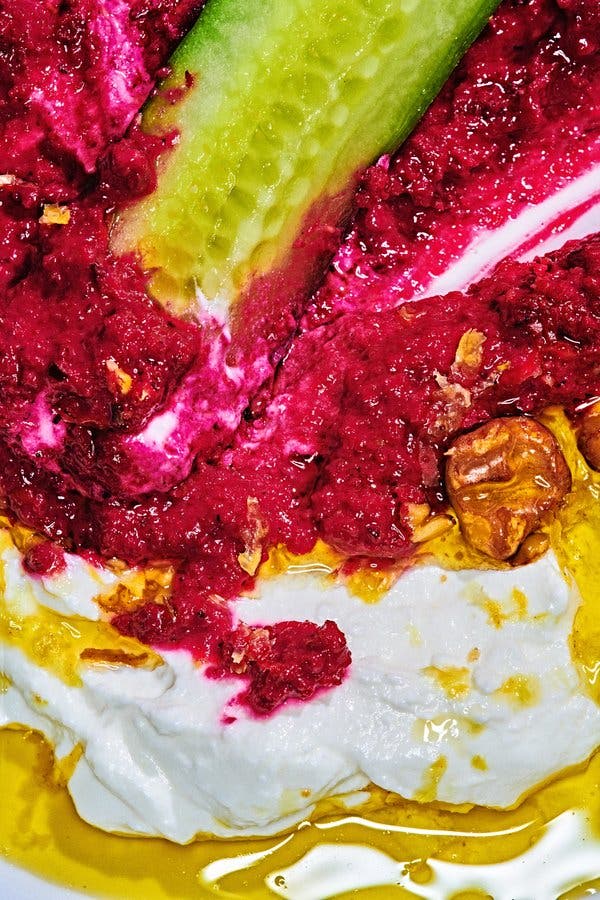If love is a kind of deep knowledge, then it’s possible no one loves beets more than Irwin Goldman, a professor of horticulture at the University of Wisconsin, Madison. He once spent about 15 years developing a beet variety that was rainbow-hued and crunchy and sweet, like a carrot. “I’d been working with yellow beets and found them incredibly beautiful,” Goldman told me. “So my first goal was to make a beet with both colors, red and yellow.” But breeding beets is slow work. Goldman spent a decade on colors, reducing reddishness and increasing yellowishness, until the pigments alternated inside the beet, within the plant tissue itself, like a miniature archery target.
Though the beets grown in ancient Greece — long and slender, red or white — were so mild they were often eaten raw, cooks today tend to boil or roast the beet, as if to temper its powerful flavor. “Beets have an earthiness,” as Goldman put it, “that tastes like dirt to some people.” That earthiness comes from geosmin, a molecule that reminds me of wet mud, of a lush garden after a heavy rain. I like it in small doses. It can also have an abrasive quality, a kind of scratchiness in the mouth, which comes from oxalic acid. And too much of this is objectively unpleasant. “To make the beet more palatable, I selected for low levels of it,” Goldman said. Over the years, he produced a sweet beet he called Badger Flame, one so gentle he could give it to his kids to snack on raw.
When seeds finally went on sale, Goldman’s beet joined a number of highly sought-after specialty beet varieties, like the sugary Candy Stripe, with its hot pink swirls. And the pale, Creamsicle-colored golden beet, with its spinachy tang. Cute beets flood the farmers’ markets in spring, when you can find them bundled with their tender greens, sold by the bunch, and I find them 100 percent irresistible. After speaking with Goldman, I’d been waiting more intently for all of the fancy beets, wondering how best to enjoy them. Roasted, I figured. Glossy and quartered and dressed up with a pile of greens. But the beets were so pretty, and so sweet, and I remembered our conversation. By the time tiny beets came to the farmers’ market, I knew exactly what I wanted to make — an adaptation of a dish I’d tried at Botanica, a vegetable-obsessed restaurant in Los Angeles owned by an old friend and her business partner, who cleverly whiz beets into a thick, satisfying dip. This would keep the beets raw, preserving their color and flavor.
The dip is a vivid shade of purple. It could be a snack, before something bigger, as it’s served at the restaurant, but I find it’s a perfect meal with a dollop of labneh, some Persian cucumbers and lots of warm pita when I’m feeling lazy and don’t want to turn on the stove. To make it, peel the beets, chop them roughly and toss them in a blender (with gloves on if you’re working with red beets, and you don’t want your fingertips stained). Everything else can go in at the same time: a juicy lemon’s worth of juice, a glug of syrupy pomegranate molasses to sweeten it and lots of olive oil and walnuts to mellow out the dip and add texture. It takes a little more salt than you think it needs, some pepper, chile flakes and a small clove of garlic. And blending, lots of blending.

Serve with cucumbers for dipping.CreditBobby Doherty for The New York Times. Food Stylist: Maggie Ruggiero. Prop stylist: Margaret MacMillan Jones.
Beets are tough work on a blender and take some time to break down. This means you need to stop a few times to scrape down the sides and just help out the machine. The result is worth it. The beets are pulverized and softened and totally rebalanced in the process, with acidity and fat and something close to winelike tannins. All their best qualities — that mild earthiness, that vegetal sugar — shine.
And while it’s great made with a handful of fancy beets, the best part about the dip came as a surprise when I was testing it at home, over and over again, with different varieties: It works especially well with nothing fancy at all, just a big, lumpy, nameless beet from the supermarket.
Recipe: Beet Dip With Labneh




